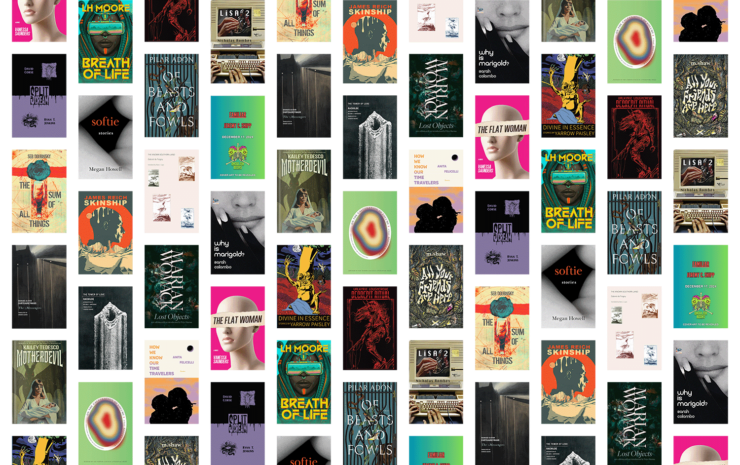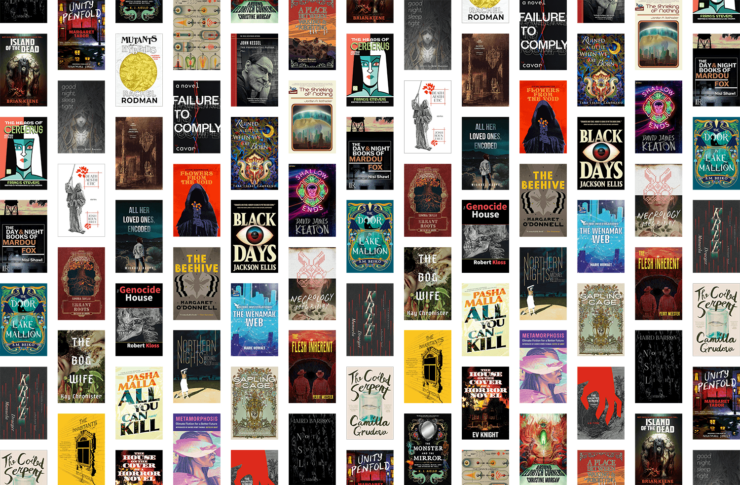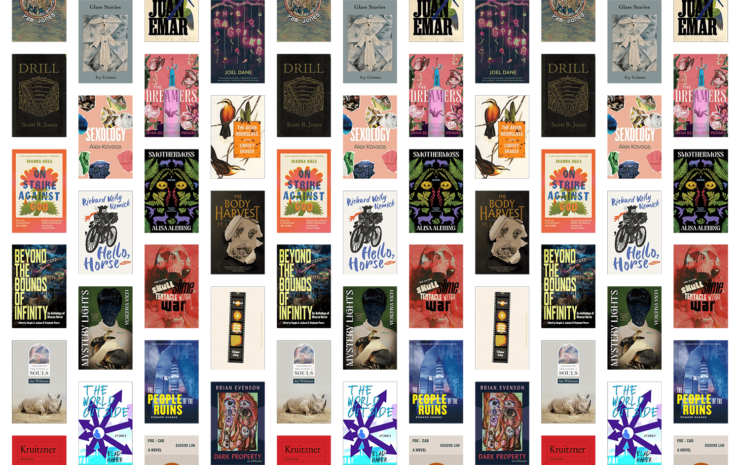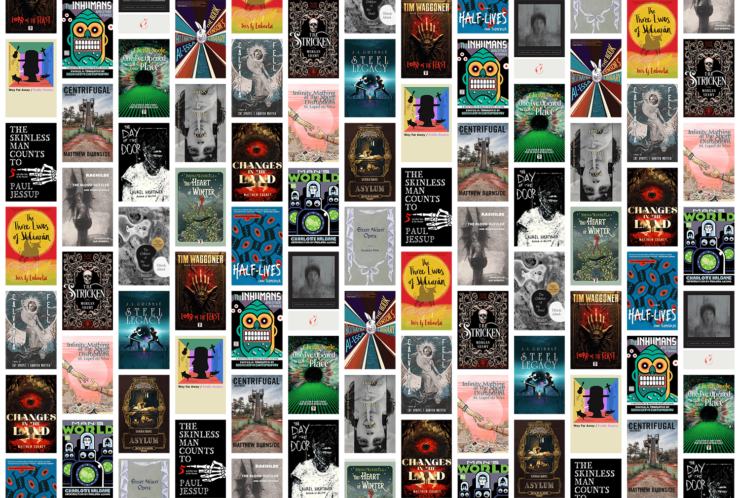The end of the year can be a quiet time for publishing, but there’s still plenty happening if you look in the right places. The SFF due out from indie presses at the end of this year abound with fiction that eludes easy classification and touches on different genres on its way. What follows is a look at some notable books due out on small presses for November and December, from Jersey Devil poetry to an anthology exploring the roots of D&D.
File Under: Bodies and Technology
There’s a long history in SFF of works dealing with artificially-created beings, and it’s into that lineage that Sarah Colombo’s new novel Why Is Marigold? steps. The title character of this book is an android whose early education led to her working in a desalination facility. An encounter with a man reveals the existence of what may be gaps in her memory, setting up a wider mystery with existential dimensions. (Spaceboy Press; Nov. 8, 2024)
Anita Felicelli’s 2019 novel Chimerica drew praise from a number of acclaimed writers, with Jonathan Lethem calling it “a coolly surrealist legal thriller.” Felicelli has returned with a new collection—her second—with the evocative title How We Know Our Time Travelers. In these stories, Felicelli reckons with some of the biggest issues facing the world today, including the evolution of technology and living in an era of environmental upheaval. (WTAW Press; Dec. 3, 2024)
Bodies can be strange, even under the most quotidian circumstances. It’s not surprise, then, to see Megan Howell explore the boundaries of where bodies can go in her new collection Softie. Howell takes her characters through surreal transformations in these stories, a work that Publishers Weekly called “a beautiful and striking collection.” (West Virginia University Press; December 2024)
For his second novel published in 2024, Nicholas Rombes takes readers to a very different place than the alternate timeline of The Rachel Papers. Rombes’s Lisa 2, v1.0 is about a vintage Apple computer that a frustrated writer begins using in the present day, only to find that it has a strange effect on her work. It’s a heady combination, with one review citing “[r]emixed hints of Bradbury, Black Mirror and Kafka” lurking within. (Calamari Archive; Dec. 1, 2024)
M. Shaw’s weird fiction has gotten attention from the likes of the Bram Stoker Awards. Shaw’s new collection All Your Friends Are Here. In a 2022 interview, Shaw said, “I will never, ever get tired of fucked up deer.” Based on the description for this collection, it sounds like fellow aficionados of unsettling deer will have plenty to observe here. (Tenebrous Press; Dec. 5, 2024)
I’ve been an admirer of Marian Womack’s work for a while now, and reviewed her novel The Golden Key in this space in 2020. That review also references a collection of hers, Lost Objects, which is now returning to print in a new and expanded edition, complete with an introduction by Priya Sharma. Think surreal environments, bodily transformations, and climate change turned bizarre and you’ll have an idea of what to expect here. (Calque Press; Nov. 16, 2024)
File Under: The Terror of Isolation
Do you enjoy your fiction abounding with mysterious societies and ominous premonitions? If so, you’re likely to savor plenty about Pilar Adón’s novel Of Beasts and Fowls, translated by Katie Wittemore. This novel abounds with Gothic imagery and uncanny connections between characters, and follows a woman mourning her lost sister whose path crosses with a group of women living in a remote home. (Open Letter; Nov. 5, 2024)
In a recent interview, Solvej Balle revealed that the concept behind her novel On the Calculation of Volume (Book I) dates back decades. Balle referred to “the idea of a woman stuck in time repeating one day again and again,” a concept that first came to her in 1987. This is also the first part of a septology, translated by Barbara J. Haveland; New Directions is also publishing the second volume this November. (New Directions; Nov. 18, 2024)
Upon gazing at the cover art for Valkyrie Loughcrewe’s Decrepit Ritual, you might think to yourself, “This could easily be a metal band’s cover artwork.” That’s no coincidence. This novel follows a depressed protagonist as they travel far from home in Norway and encounter a film that appears to defy multiple laws of reality. Do you like your fiction abounding with visceral imagery and analog media? Tune in here. (Ghoulish Books; Nov. 26, 2024)
As fans of the film The Lighthouse (or this SNL sketch) can tell you, the combination of isolation and elemental forces can make a lighthouse keeper’s life uncanny under most circumstances. In Rachilde’s novel The Tower of, translated by Jennifer Higgins, a man takes a job working at a lighthouse on the French coastline that quickly takes a turn for the phantasmagorical. (Wakefield Press; November 2024)
James Reich’s bibliography rarely stops at the same place twice. It’s large enough to encompass explorations of colonialism along with mystical conspiracies; it’s hardly shocking, then, that his next novel is going full-on science fictional. That would be Skinship, a story of a spacecraft carrying the last of humanity and the sole survivor left behind on Earth. It might not be the last time he returns to this setting, if this interview is any indication. (Anti-Oedipus Press; December 2024)
File Under: History and Mythology
In 1979, TSR published Gary Gygax’s first Dungeon Master’s Guide, which included a list of stories that Gygax cited as an inspiration for Dungeons & Dragons. It’s with that in mind that editor Peter Berbergal assembled Appendix N, revised and expanded edition: Weird Tales From the Roots of Dungeons & Dragons, which features work by the likes of Jack Vance, Andre Norton, Clark Ashton Smith, and Ramsey Campbell. Throw in an introduction by Adrian Tchaikovsky and an afterword by Ann VanderMeer and you have the makings of an appealing read. (Strange Attractor Press; Nov. 26, 2024)
In this 1676 novel, a European traveler arrives on a continent called Australia—but it’s not the one that we’re all familiar with. Instead, Gabriel de Foigny’s The Known Southern Land—here translated by Dana J. Lupo—is a collectivist utopian society at odds with both colonial expeditions and massive predatory birds. It’s a singular utopia that revisits the past in multiple ways. (Spurl Editions; Nov. 21, 2024)
Some collections zero in on one aspect of their author’s bibliography. In the case of LH Moore’s Breath of Life, the opposite is true: this collection spans fiction, essays, and poetry, with stylistic trips into both horror and Afrofuturism. It’s a wide-ranging work; in their review, Publishers Weekly noted that it “[felt] like a career retrospective.” (Apex Book Company; Dec. 17, 2024)
You probably haven’t read a creation story like the one found in Yarrow Paisley’s Divine in Essence before. Ghosts, Furies, and residents of the other side of the mirror all make appearances in this surreal spin on the world around us, Paisley’s follow-up to his acclaimed 2017 collection I, No Other. (Whisk(e)y Tit; Nov. 1, 2024)
Cards on the table here: I grew up in New Jersey and I like cryptids. So when I heard that Kailey Tedesco had written a book of poetry inspired by the origins of the Jersey Devil, I did not need much convincing to have my interest piqued. The book in question is Motherdevil, which is in part about Mother Leeds — perhaps better known as “the Jersey Devil’s mom.” I’m so here for this. (White Stag Publishing; Nov. 1, 2024)
File Under: Strange Cities and Uncanny Families
The combination of writer Georges-Olivier Châteaureynaud and translator Edward Gauvin won an SFF Translation Award in 2011 for the book A Life on Paper. That same writer-translator tandem returns to Anglophone letters with The Messengers, a surreal tale of a young man making his way across a bizarre landscape interspersed with scenes of horror and mystery. (Wakefield Press; November 2024)
World Fantasy Award-nominated writer Seb Doubinsky returns this fall with his novel The Sum of All Things. It’s the latest installment in his long-running City-States Cycle, a project Doubinsky has compared to Michael Moorcock’s Jerry Cornelius books. This novel blends political intrigue, royal succession, and radical violence in a milieu that’s at once familiar and unexpected. (Meerkat Press; Nov. 5, 2024)
There’s something eminently rewarding about a volume collecting two works of fiction by disparate writers. (Yes, I read a lot of Tor Doubles growing up, why do you ask?) The latest installment of the Split Scream series features work by Ryan T. Jenkins and David Corse, novelettes that reckon with strange portals and haunted houses. (Tenebrous Press, Nov. 12, 2024)
You might never look at seagulls the same way again after reading Vanessa Saunders’s novel The Flat Woman. It’s set in a world where environmental distress has caused the seabirds in question to die en masse, and to which the misogynist response has been to pin the blame on a nonexistent group of female terrorists. Of the book’s style, Saunders said that she sought one “that expresses our absurd, fast, and unpredictable modern world filled with screens, disasters, and polarization.” (University of Alabama Press; November 2024)
Jeremy C. Shipp’s previous novel The Merry Dredgers followed its characters on a surreal trip through cults and abandoned carnivals. At the heart of that novel was the bond between two siblings; a very different connection between two sisters can be found in Shipp’s new book Familiar. This one’s about sisters engaged in magical activities with a penchant for tracking down killers; it’s another entry in Shipp’s compelling bibliography. (Ghoulish Books; Dec. 17, 2024)














